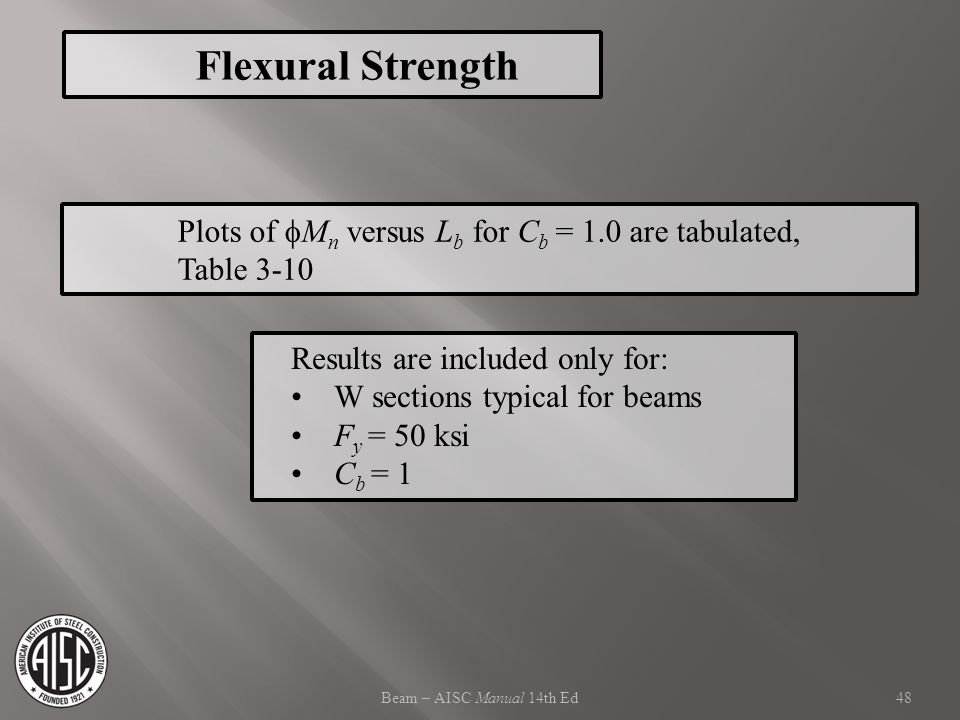
The program will use serviceability limit state for standard holes (STD) or slots transverse to the direction of load (SSLH, LSLH). Slip Critical calculations are not supported for the CSA S16-09 or the CSA S16-14 design codes. This method was taken from the "Design of All-Bolted Extended Double Angle, Single Angle, and Tee Shear Connections" by Perry Green, Thomas Sputo, and Adam Higgins. See Bolt Group Eccentricity for more information on the calculation of the C coefficient. The slip critical value is multiplied by the C coefficient determined from the Center of Rotation method or the Elastic method specified in the Global Parameters. The bolts can be considered slip critical if you select Slip Critical Class A or Class B listed in the Components Bolts section. This check is calculated per equation J3-4 of the AISC 360-10 specification. Because there is no formal layout of parameters the AISC 13th edition was used.
#Aisc 14th edition table 3 10 manual#
CSA (S16-09 and S16-14) Shear Tab Connectionsįrom page 3-70 of the manual there is a discussion of how eccentricity was considered in the following table. Because the AISC manual is more detailed regarding this the 13th edition criteria are also used here. CSA (S16-09 and S16-14) Double Angle Connectionsįrom page 3-58 of the manual the eccentricity can be ignored for single row of bolts in the web-framing leg. Bolts located at gages not exceeding 3"ĪISC 14th Edition (360-10) Shear Tab Connectionsįor shear tabs that meet the standards of the conventional configuration, Table 10-9 is used.For standard holes with n = 10 to 12, use e = n-4 and 1.25 factor on C.ĪISC 14th Edition (360-10) Double Angle Connections.Single row of bolts through the web of the supported beamĪISC 13th Edition (360-05) Shear Tab Connectionsįor shear tabs that meet this criteria, the bolt group eccentricity coefficient can be ignored (per page 10-102 of manual):.AISC 13th Edition (360-05) Double Angle Connectionsįor double angles that meet this criteria, the bolt group eccentricity coefficient can be ignored (per page 10-8 of manual): Considered checkbox is unchecked on the Global Parameters - Solution tab.
#Aisc 14th edition table 3 10 full#
If you wish to ignore the eccentricity when these codes allow for it make sure the Full Shear Ecc.

This is because moment connections have the rotational restraint in the flanges, thus not allowing the rotation to occur that is typical in a simple shear connection.īoth the AISC and CSA codes give parameters when this eccentricity can be ignored for the Bolt Shear Strength check.

This was ignored for AISC even though it is unconservative. This is enforced for the CSA S16-09 and the CSA S16-14 codes, but is NOT enforced for the AISC codes. Bolts up to an inch in diameter have a strength of 120 ksi, larger bolts have a strength of 105 ksi. When bolts are designated with a material property of A325, the bolt strength in the ASTM varies based on the bolt diameter. The material properties of metric bolts are not exactly equal to the imperial ASTM with the same designation as there is as much as a 0.5% difference between 120 or 150 ksi used in the imperial ASTMs and the 830 or 1035 MPa used in the metric ones.

Metric bolt sizes are only available when using A325M or A490M. The following ASTM bolt material designations are available in RISAConnection: These bolts checks are common to many different connection types.


 0 kommentar(er)
0 kommentar(er)
